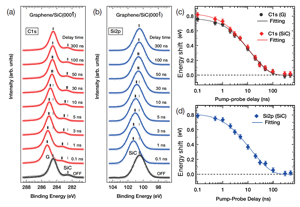Interfacial Carrier Dynamics of Graphene on SiC, Traced by the Full-Range Time-Resolved Core-Level Photoemission Spectroscopy at SPring-8 BL07LSU
I. Matsuda Group
Time evolutions of the Dirac Fermions in graphene layers have attracted both academic and technological interests due to observations of the various intriguing opto-electric phenomena, such as carrier multiplications and generation of a terahertz laser. Nowadays, graphene layers can be epitaxially grown on a SiC substrate in wide area and such non-equilibrium carriers in the Dirac bands have been directly probed by time-resolved photoemission spectroscopy. On the other hand, the previous studies focused only on electronic evolutions within a graphene layer and little examination was made on carrier dynamics through the graphene/substrate interfaces. Unveiling dynamic roles of the graphene/SiC interface is necessary to understanding the opto-electric properties in SiC based detectors, for example.

Fig. 1. Time-resolved photoemission spectra for (a) C 1s and (b) Si 2p core levels of graphene layers on the SiC substrate. In (a), graphene peaks (labeled G) and SiC peaks (labeled SiC) were distinguishably observed. The spectral energy shift measured from the laser OFF was extracted and shown as a function of time for (c) C 1s and (d) Si 2p core levels.
In the present research, we conducted measurements of time-resolved core-level photoemission spectroscopy by a combination of laser and synchrotron radiation [1]. The experiment was performed at SPring-8 soft X-ray beamline BL07LSU with the beamline laser station, BL07LASER. Figure 1 shows temporal variations of peak positions of C 1s and Si 2p during relaxation of the surface photovoltage effect, induced by the optical pumping with a laser pulse. Two C 1s components are assigned to a graphene layer (G) and a SiC substrate (SiC), while one Si 2p component originates from a SiC substrate. Thus, the high-resolution core-level spectra selectively distinguish dynamical information between overlayer and substrate. While the whole relaxation of the electron-hole recombination process takes 100 nanoseconds, one can also find difference in temporal variation between C and SiC in the subnanosecond region. This is because carrier lifetime in the graphene layers take longer than that of the typical interface-state of SiC by the bottleneck effect of Dirac cones. When there is a buffer layer between graphene and SiC, electron-hole recombination is dominantly held at the interface and the lifetime shortens one-order of the magnitude [1]. The selective evaluations of carrier dynamics in non-uniform samples, such as heterojunctions, allow one to design and develop novel optoelectric devices.
References
- [1] T. Someya, H. Fukidome, N. Endo, K. Takahashi, S. Yamamoto, and I. Matsuda, Appl. Phys. Lett. 113, 051601 (2018).
